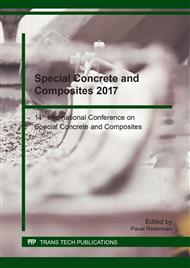[1]
V. Kodur, Properties of Concrete at Elevated Temperatures, Civil Engineering, vol. 2014, (2014), pp.1-15.
Google Scholar
[2]
A.N. Noumowe, R. Siddique, G. Debicki, Permeability of high-performance concrete subjected to elevated temperature (600°C), Construction and Building Materials, vol. 23, (2009), pp.1855-1861.
DOI: 10.1016/j.conbuildmat.2008.09.023
Google Scholar
[3]
J. Koťátková, J. Zatloukal, P. Reiterman, J. Patera, Z. Hlaváč, P. Brabec, The effect of elevated temperatures and nuclear radiation on the properties of biological shielding concrete, Key Engineering Materials 677 (2016) 8-16.
DOI: 10.4028/www.scientific.net/kem.677.8
Google Scholar
[4]
Heat Resistance Concrete or Refractory Concrete – Installation and Applications, available form: https: /theconstructor. org/concrete/types/heat-resistant-concrete-refractory-uses/16812.
Google Scholar
[5]
M. Jog., J. Koťátková, P. Reiterman, Differences in the mechanical properties of lightweight refractory cementitious composites reinforced by various types of fibers, Key Engineering Materials 667 (2016) 29-32.
DOI: 10.4028/www.scientific.net/kem.677.29
Google Scholar
[6]
E. A. Firoozjaei, A. Saidi, A. Monshi, P. Koshy, The effect of microsilica and refractory cement content on the properties of andalusite based low cement castables used in aluminium casthouse, Ceramica, vol 56, (2010).
DOI: 10.1590/s0366-69132010000400016
Google Scholar
[7]
T. Pavlů, M. Šefflová, V. Hujer, The properties of fine-aggregate concrete with recycled cement powder, Key Engineering Materials 677 (2016) 292-297.
DOI: 10.4028/www.scientific.net/kem.677.292
Google Scholar
[8]
T. Pavlů, V. Kočí, M. Šefflová, Study replacement of cement with recycled cement powder and the environmental assessment, Solid State Phenomena 249 (2016) 136-141.
DOI: 10.4028/www.scientific.net/ssp.249.136
Google Scholar
[9]
P. Hála, R. Sovják, M. Frydrýn, T. Mičunek, Energy absorbing system made of high performance concrete, Construction and Building Materials, vol. 139, (2017), pp.64-80.
DOI: 10.1016/j.conbuildmat.2017.02.048
Google Scholar
[10]
J. Koťátková, P. Reiterman, Effects of different types of steel fibers on the mechanical properties of high strength concrete, Advanced Materials Research 1054 (2014) 80-84.
DOI: 10.4028/www.scientific.net/amr.1054.80
Google Scholar
[11]
M. Jogl, P. Reiterman, O. Holčapek, J. Koťátková, Influence of high-temperature on polycarboxylate superplasticizer in aluminous cement based fibre composites, Advanced Materials Research 982 (2014) 125-129.
DOI: 10.4028/www.scientific.net/amr.982.125
Google Scholar
[12]
CSN EN 196-1 Methods of testing cement – Part 1: Determination of strength, (2005).
Google Scholar
[13]
CSN EN 12 504-4 Testing concrete – Part 4: Determination of ultrasonic pulse velocity.
Google Scholar
[14]
B. Zhang, N. Bicanic, Fracture energy of high performance concrete at temperatures up to 450°C, Fracture Mechanics of Concrete Structures, (2001), 461-468.
Google Scholar
[15]
Z. P. Bažant, M. T. Kazemi, Size dependence of concrete fracture energy determined by RILEM work-of-fracture method, International Journal of Fracture, vol. 51, (1991), pp.121-138.
DOI: 10.1007/978-94-011-3638-9_9
Google Scholar
[16]
C. V. Nielsen, N. Biéanić, Residual fracture energy of high-performance and normal concrete subject to high temperatures, Materials and Structures 36, (2003), 515-521.
DOI: 10.1007/bf02480828
Google Scholar


